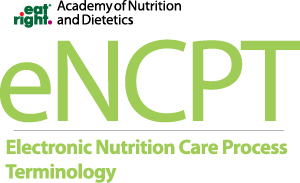The Nutrition Care Process (NCP) is a systematic approach to providing high quality nutrition care. The NCP consists of four distinct, interrelated steps:
- Nutrition Assessment: The RDN collects and documents information such as food or nutrition-related history; biochemical data, medical tests and procedures; anthropometric measurements, nutrition-focused physical findings and client history.
- Nutrition Diagnosis: Data collected during the nutrition assessment guides the RDN in selection of the appropriate nutrition diagnosis (i.e., naming the specific problem).
- Nutrition Intervention: The RDN then selects the nutrition intervention that will be directed to the root cause (or etiology) of the nutrition problem and aimed at alleviating the signs and symptoms of the diagnosis.
- Nutrition Monitoring/Evaluation: The final step of the process is monitoring and evaluation, which the RDN uses to determine if the client has achieved, or is making progress toward, the planned goals.
Using the NCP does not mean that all clients get the same care. Use of a care process provides a framework for the RDN to individualize care, taking into account the clients needs and values and using the best evidence available to make decisions. Other disciplines in healthcare, including nursing, physical therapy and occupational therapy have adopted care processes specific to their discipline. In 2003, the Academy's House of Delegates adopted the NCP to provide RDNs with a framework for critical thinking and decision-making — leading to more efficient and effective care and greater recognition of the role of RDNs in all care settings.
At first the Nutrition Care Process may seem like a linear approach; however, during the course of an interaction/appointment with a client, the RDN will often complete the assessment and diagnosis steps, and may begin a Nutrition Intervention when a client reveals another piece of new assessment data/information that will cause the RDN to re-assess, and re-diagnose and perhaps modify the plan that he/she had started discussing with the client. Therefore, the Nutrition Care Process is represented as a circle in the Nutrition Care Model.
What is the Nutrition Care Process and Model?
The Nutrition Care Process is a standardized model intended to guide RDNs in providing high quality nutrition care. The snapshots listed below provide a brief overview of each step of the Nutrition Care Process:
- Nutrition Assessment Snapshot
- Nutrition Diagnosis Snapshot
- Nutrition Intervention Snapshot
- Nutrition Monitoring and Evaluation Snapshot
The Nutrition Care Model is a graphic visualization that illustrates the steps of the Nutrition Care Process as well as internal and external factors that impact application of the NCP. The central component of the Model is the relationship of the target client or group and the RDN. One of two outer rings represents the skills and abilities of the RDN along with application of evidence-based practice, application of the Code of Ethics, and knowledge of the RDN. The second of two outer rings represents environmental factors such as healthcare systems, socioeconomics and practice settings that impact the ability of the target group or client to benefit from RDN services. Screening and referral and outcomes management are also components of the model.
Nutrition Care Process Resources
What does the eNCPT (electronic Nutrition Care Process Terminology) provide?
- The eNCPT contains a narrative describing the Nutrition Care Process and is broken down by each Nutrition Care Process step. Critical thinking skills are highlighted for Nutrition Assessment, Nutrition Diagnosis, Nutrition Intervention, and Nutrition Monitoring and Evaluation. There are pages in the Nutrition Diagnosis section that highlight how to formulate PES statements. This section also includes interactive matrices in assisting dietitians to formulate PES statements. The Nutrition Assessment and Nutrition Diagnosis Etiology Matrices are also available to subscribers as downloadable PDF documents.
- The eNCPT contains interactive terminology lists. The terminology lists are organized by NCP step (Assessment, Diagnosis, Intervention, Monitoring & Evaluation) and then broken down further by domain. The interactive terminology lists link to the respective term's reference sheet. Also available within this section are Terminology Lists downloadable as PDF documents.
- Included within an eNCPT subscription are all the reference sheets for all the terminology, consistently organized by NCP step (Assessment, Diagnosis, Intervention, Monitoring & Evaluation) and then broken down further by domain. Dietitians refer to the reference sheets to read in depth about a specific term, its definition, and, if appropriate, its etiologies, signs and symptoms, etc.
- Organizational Subscribers and Developer Subscribers to the eNCPT have access to a downloadable spreadsheet that contains all the terminology. This spreadsheet outlines the hierarchy of the terminology, includes alphanumeric codes that many IT departments use in building their facility’s EHR, and provides codes that reference how the terminology is being mapped to the SNOMED/LOINC body of medical terminology.
For more information on the various subscription categories, visit the Subscription Categories Explained page.
